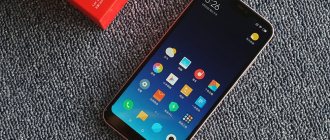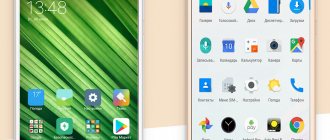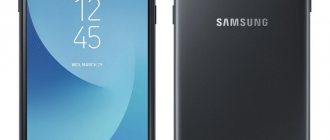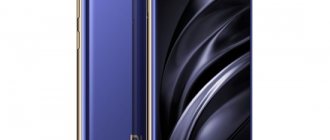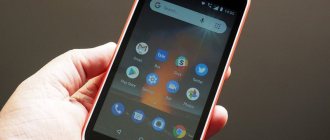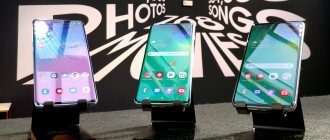Communicator HP iPAQ hw6915 , this is the receiver hw6515. Compared to its predecessor, the model we are considering has a better processor and more memory, but the screen resolution and size remain the same. The device is made in a monoblock form factor and is equipped with a full QWERTY keyboard. Compared to the total mass of communicators on the market, the HP iPAQ hw6915 is not the smallest or the fastest, but in terms of the totality of its functionality, the device can satisfy the needs of the average user.
The system on the HP iPAQ hw6915 will be running the Windows mobile 5.0 , and in total it is a combination of a Pocket PC phone and a PDA (PDA). It is impossible not to mention the wide capabilities of the communicator in terms of data transfer. It is equipped with Wi-Fi, Bluetooth 1.2 and a GPS module, and also supports GPRS and EDGE connections.
Design
HP IPAQ hw6915 has the same size as its predecessor hw6515 - 118 x 71 x 18 mm, compared to the average smartphone, the dimensions are average, which cannot be said about the weight of the device, which is 179 grams (including the battery). For example, Motorola Q is not much smaller in size, but in terms of weight it wins 57 grams (Motorola Q weighs 122 grams). True, if you were a user of i-mate JAM, JAMin or O2 Atom, then at first you will experience inconvenience, but if you were a user of hw6515, then you will not have any discomfort at all about the size and weight of the phone.
You can study the arrangement of elements on the body using this diagram.
Front Panel
- Speaker
- Light emitting diode (LED) indicator indicating battery charging status
- LED indicator indicating Bluetooth/Wi-Fi status
- Pen (another name for Stylus).
- Power button
- Touch screen
- End call key
- Mini-SD memory card slot
- Right soft key
- Alphanumeric keyboard with LED backlight.
- Reset button
- Charger input
- Microphone
- Stereo headphone and microphone input
- Five-way navigation key
- Left soft key
- Infrared port
- Call answer key, also known as dialing
- Camera key
- Double key to adjust sound volume
Back panel
- LED flash
- HP digital camera
- Mirror
- Speaker
- Battery cover
The device has a full QWERTY keyboard. It has a full set of keys, they are round with a fairly large distance between them. When pressing, the feedback is felt well, but the keyboard does not feel rigid. Compared to the HP IPAQ hw6515, the keys have become more comfortable, but people with large fingers will still need time to get used to the keyboard. A little higher is the standard set of keys for controlling the phone - answer/reset keys, two soft buttons and a navigation key. They are located conveniently, making a mistake when pressing is almost impossible. The five-way navigation key is hard. The backlighting of the keys is quite good; you won't have any difficulty typing in low light conditions. The screen has a diagonal of 3 inches and is touch-sensitive. The necessary actions on it can be carried out either with a pen (stylus) or with your fingers. The screen resolution is 240 x 240 pixels, but, in my opinion, it would be more convenient to use the standard QVGA (240 x 320 pixels) resolution; most programs are adapted specifically for this resolution. But on the other hand, at a resolution of 240 x 240 it is more convenient to work with SMS messages, or view photos or videos in full screen mode. Brightness and contrast are at the level that this screen can provide. It is made using TFT technology and is capable of reflecting up to 65,000 colors.
The cover that hides the battery compartment fits tightly, without play. Below it is a lithium-ion battery with a capacity of 1200 mAh. According to the developers, it should provide up to 4 hours of talk time and up to 170 hours of standby time. But these figures are relevant if you use the HP iPAQ hw6915 as a phone, but it is worth considering that it has a GPS module installed, which significantly increases battery power consumption. If you use the device directly as a GPS, the battery life is reduced to three hours. From this it is clear that it is impossible to determine the average operating time of a communicator, as could be calculated for ordinary cell phones.
HP iPAQ 4150 PDA: DIY chargers, cables!
Are you tired of buying expensive cables and chargers for your PDA that also refuse to work? Then we go to you!
One day, a brilliant idea comes into your bright head that another data cable to your PDA will add a drop of long-awaited happiness to your worthless life. You, shining like a freshly printed hundred-dollar bill, joyfully walk into the store, clutching the treasured thousand-ruble note in your fist.
The cunning seller offers several cables for your “baby” to choose from. And in the form of a tape measure, and with a power switch, and a cable with removable connectors, with which you can connect your phone, mp3 player, card reader and almost a vacuum cleaner to your computer. To the modest question of why the cable says “1940” or “2210” when you asked for a universal cable for synchronizing and charging the HP 4150, the seller will of course answer that these are Chinese (Koreans, Vietnamese or people from HP - this is not particularly important for the seller) in Pocket Computers they understand absolutely nothing, and he is exclusively a revelation of God and the embodiment of Knowledge about the PDA, despite the fact that a month ago he was selling rotten tomatoes at the station market. Here, of course, is the time to spit in the seller’s face and go home, rejoicing in the money and nerves saved, but we are the smartest, we buy it. And this is where the fun begins.
When we get home we realize that nothing is working. The smartest people go online and realize that nothing should work here. Because:
Q1) USB charging takes an unnaturally long time. About like ballet (this is when after 3 hours you realize that only a little has passed). This is due to the fact that according to the USB standard, a current of 0.5 Ampere (500mA) is supplied to the port. This is provided that the manufacturer of the motherboard (or USB hub) did everything as expected and according to the standard. In practice, it may turn out to be less, especially on older PCs.
A1) The average bright mind comes to the thought of buying “an adapter for charging USB devices from a 220V electrical outlet.” Rejoicing at our immeasurable genius, we go to the ill-fated “tomato” seller (or to any other store offering “a huge selection of high-quality accessories for PDAs from leading high-quality cable” in the same store. This is where we need to run away and eeeeeee spit in the seller’s face. Because In almost any stall selling mobile phones (in Moscow) or in any company selling computer components in a large assortment, the cost of this wonderful device ranges from 100 (in words: “one hundred”) full wooden rubles. The maximum I have seen is 250. Again , they differ in current strength, but the minimum that I personally have encountered is 650mA (we still need to try to find this).
A2) USB charging does not suit you for some reason. Moreover, as it is not surprising, at the dacha her beloved mother-in-law does not have a computer from which she could recharge her PDA, and she wants to read her favorite books, because the only alternative entertainment within a radius of one hundred kilometers is poking around in the ground with her butt up in a garden bed strawberries Do you have an old mobile phone charger with a broken connector that has been collecting dust in the closet for three years now? Amazing! It can be converted into a PDA charger from a 220V network.
Q2) A cable with USB charging, which does not have the ability to turn off charging (with a switch). At the moment of synchronization, the USB Host Controller miraculously puts the USB Host Controller in the knee-elbow position. So much so that it does not work at all and in no way until the subsequent reboot. According to untrustworthy rumors, in the worst case, the south bridge of the chipset may suffer. Moreover, up to the physical burnout of the microcircuit. This danger is more than real for computers with a motherboard based on the Intel i865 chipset (Asus P4P800, Gigabyte 8IPE1000 of all modifications).
A1) Assuming the cable is assembled correctly, all that remains is to add the switch. We buy a suitable one from stores that sell electronic components and modify the cable.
Q3) Synchronization does not work. Why is not known. We insert it into the computer - no reaction. The PDA does not see ActiveSync. The cable says “HP 1930”, “HP 1940” or “HP 2210” (why such a choice of models? It’s just how most noname cables are labeled).
A1) Analyze the cable diagram and correct errors. More often than not, it turns out to be easier to disassemble it and reassemble it correctly than to tinker with what our yellow-faced brothers have done there.
Q4) I want a cheap and working cable. What is needed for this?
A1) We buy any, the cheapest cable for modern HP iPAQs and finish it ourselves. Once I became the owner of a “product” from XDM for 117 rubles (I bought it at a sale from a well-known company that sells components), and in 15 minutes it was brought to working condition.
A2) We assemble it ourselves.
This requires:
Any USB cable. The main condition is the presence of a regular USB connector on one side:
-Cable from a dead USB mouse -Cable from an mp3 player -USB extension cable included, for example, with Transcend flash drives or with Card Reader -USB cable from a printer -In Auchan stores, for example, you can buy a USB cable like “AB” for 18 rubles (only they are not always working). -You can buy a USB connector at the store. The only subtlety when assembling it is that the <ground> signal from the USB port (black wire) is supplied to the connector body.
Connector to PDA (22 pins with 0.5mm pitch):
-We are looking for cables at sales and flea markets in the “substandard” and “discount” sections. The main condition is the integrity of the connector to HP.
-We buy it in the store.
Oddly enough - a soldering iron (you can, of course, glue everything with tape, but something tells me that it won’t stick very well). Maximum 30W. Grandfather's 100W for soldering holes in pans, manufactured in 1957, is still too big.
A device with the indecent name “suction”. Costs 30 rubles. We need it in one case - to remove excess tin (in case we short-circuit something unnecessary or if we disassemble the cable for subsequent human assembly).
Tin, solder - to taste.
Let's get started:
So, we have put everything together, the soldering iron has warmed up, what to do next? It's simple. We disassemble the HP connector, look, think for a long time (it is disassembled by pressing four latches using a needle or a very small screwdriver).
The most difficult thing that can happen in our entire event is determining the orientation of the connector. We look at the red and black wires.
We solder everything according to the figure below. We carefully look at what happened to check for unnecessary connections (NB: only USB pins are indicated in the figure, the rest are not empty at all, RS-232 is output to them). It is advisable to check the absence of contacts with a voltage meter, especially between “ground” and “+5V” =)
We collect. If the wire just sticks out of the HP connector and is not secured with braiding, then it is advisable to fill it all with glue. Any super-glue of the “moment” or “second” system is very suitable for this (don’t be alarmed, they are not electrically conductive, so nothing bad will happen).
The cable is ready!
How it all works:
Grounding. Connects the corresponding USB output, the USB connector housing (for secure connection) and pins: 10, 15, 22.
Data+ and Data- are supplied to pins 19 and 21 of the connector. Used to transmit data.
+5V is the most interesting. Connects legs 1,2,3,4. Contact with pin 17 is responsible for the computer detecting a new device and launching the ActiveSync program. And most importantly: the power switch (for the possibility of charging with this cable and, if it is in the “off” position, for synchronization) must be located after the +5V signal is branched to the 17th leg.
The +5V signal must always be supplied to pin 17, regardless of the switch position! In 99% of cases, this is precisely the reason why the cable with HP 4150 does not work.
UPD by Casper5011 : casper5011 (sabachko) gmail. com
And I had a connector in the HP 2210 PDA itself. I was thinking, what’s the point of getting a 22-pin connector and then bothering with its installation? COM port is absolutely not needed. Taking this opportunity, I will replace it with a mini-USB, according to the wiring provided. Perhaps even with a toggle switch for charging/synchronization.
I made a circuit diagram, checked it, it works (the standard connectors were removed due to their breakdown, mini-USB from a dead MP3 player and from a dead Motorola were soldered in). Based on materials from pinouts.ru/PDA/ipaq_22p_pinout.shtml Suitable for HP iPAQ h1910, h1915, h1920, h1930, h1935, h1937, h1945, h2200, h2210, h2215, h3800, h3900, h4150, h4155, h4300, h models 4350, h4355, h5100, h5155, h5400, h5500, h5450, h5455, h5500, h5550, h5555, h6315, h6340, h6340, h6365, hw6510, hw6515, hx2000, hx2100, hx2400, hx2700, hx47 00, hx4705
Tested on 2210 and 1945.
Who needs it - use it for your health.
Connectivity
Connectivity and data transfer capabilities are one of the main advantages of the HP iPAQ hw6915 . GSM cellular networks of the 850, 900, 1800, 1900 MHz standard, and accordingly can operate in operator networks around the world. For GSM networks it also supports GPRS and EDGE. Both have class 10, which allows you to get good connection speed when using the Internet. Other features include support for Wi-Fi, USB 1.1 infrared and Bluetooth, but first things first. Reception and signal quality in GSM networks is good. During a conversation, the interlocutor can be heard clearly, without extraneous noise. On the other hand, your voice is also heard well, and in general there are no complaints about this part of the functions. In addition, the device supports second line services, forwarding, and conference mode support.
Connection type options can be easily managed in the iPAQ Wireless Connection Manager, which is located on the main window of the communicator. The manager contains an icon for an infrared port, Bluetooth, Wi-Fi, telephone and GPS connections. There you can also activate and deactivate Bluetooth and Wi-Fi. The icons also show the status of the device - on, off, receiving data. The connection quality in all connection types is at a good level and has good signal reception. The Bluetooth module is version 1.2, its operation is ensured by the corresponding software version 1.7.1. The software provides several types of data transfer for Bluetooth - File Transfer, Serial Port, Information Exchange, Hands Free, Person Network Server, HID (for Bluetooth keyboard and mouse), PAN (connection to the Internet via a computer), ActiveSync, DUN (dial up connection) and A2DP (allows you to use Bluetooth stereo headset). The iPAQ performed well with Bluetooth headsets such as the Plantronics Discovery 640, Motorola HS820 and Motorola HF800. Each headphone had stable signal reception, good volume, and sound clarity, both when listening to music and when talking. Wi-Fi manager includes a number of interesting features. In the Advanced settings section, you will have access to basic characteristics such as connection status, signal strength, SSID, Tx value, connection method, BSSID, MAC and IP address. This connection uses the 802.11b standard, and provides a fairly strong signal at a distance of 30 meters from the Wi-Fi access point. the HP iPAQ hw6915 lacks is support for third generation networks (3G), but given that these networks are not supported in Russia, this drawback should not worry the Russian user.
GPS
At the moment, there is a need in the communicator market for devices with an integrated navigation system. Soon it will be difficult to imagine a communicator without a navigation system, for example, just as it is now difficult to imagine a cell phone without a camera. At the moment, not many communicators can boast of having a navigation system, so the fact that the HP IPAQ hw6915 GPS installed is a good addition to the capabilities of the device.
GPS operates using pre-installed software on your device, which includes the TomTom navigation map package. GPS software and download additional map sets. As for the signal reception quality, it is good, the system also quickly detects changes in your position while moving. If you additionally use a GPRS/EDGE connection, you can improve the accuracy of GPS . The navigation system can display a map of both large territories (for example, within a small country or region, region, if we talk about Russia), and maps of an individual locality or city. But, as I wrote earlier, when using GPS , battery consumption increases dramatically, and the battery life is about three hours. And if you plan to often use the communicator as a navigation system (for example, in a car), then you will have to buy an additional charger for the car (not included in the package) in order to comfortably use this function.
Performance
The HP iPAQ hw6915 Intel processor by communicator standards with a clock frequency of 416 MHz. In fact, the device performs all tasks well, applications do not freeze during operation and work quite quickly, the only complaint is the delay when launching applications. the Windows Mobile 5.0 operating system , and applies to all devices using this OS. This is because the operating system uses ROM memory to store programs, rather than the faster RAM. But it’s worth noting that this decision by the developers rests on the insufficient power of the battery, which discharged an order of magnitude faster when using RAM as the main one. As for the size of the memory installed on the phone, the developers equipped the communicator with 64 MB RAM and 128 MB ROM.
HP iPAQ 214
Description
HP iPAQ 214 Enterprise Handheld is a classic pocket computer, with the ability to use a Bluetooth GPS navigation receiver.
The PDA is equipped with a large 4-inch display with VGA resolution. Instead of miniature microSD cards, it is possible to use larger, but more capacious and cheaper SD and Compact Flash, which also makes it possible to connect a variety of peripherals. At the same time, support for Wi-Fi wireless networks and the Bluetooth interface is provided, which makes it easy to use the HP iPAQ 214 Enterprise Handheld for Internet telephony. Now device users have access to a unique free service, Yandex.Traffic for AUTOSPUTNIK. In addition to displaying traffic jams on the navigator screen, AUTOSPUTNIK skillfully lays out routes to bypass existing traffic jams.
Characteristics
Device specifications:
| Platform | Windows Mobile 6 |
| Device type | pocket computer |
| Memory | Random access memory (RAM/RAM): 128 MB Internal memory (ROM/ROM): 256 MB |
| Screen: | VGA 480 x 640 pixels 65k Screen diagonal 4″ |
| Performance | Processor: Marvell PXA310, 624 MHz |
| Expansion slots | SD, CompactFlash I, CompactFlash II, MMC, SDIO |
| GPS receiver | Possibility of connecting a Bluetooth GPS receiver. There is no built-in GPS. |
| Nutrition | Removable battery Battery capacity: 2200 mAh |
| Communication capabilities |
|
| Multimedia, additional features |
|
| Supported formats/compatibility |
|
| Control | touch screen, joystick |
| Dimensions | 192 |
Download
- User Guide AUTOSPUTNIK for Windows Mobile (PDF | 2.1 MB)
- — a complete user manual for the AUTOSPUTNIK navigation program for self-installation on a PDA, communicator or smartphone on Windows Mobile. (including the section connecting the free Yandex.Traffic service).
- Microsoft ActiveSync 4.5 - Russian (~7.7 MB)
- - allows you to connect a PC (except PCs running Windows Vista), manage files and synchronize the contents of PDAs running Windows Mobile 2003 and later versions.
- Windows Mobile Device Center (~12.5 MB)
- - allows you to connect to a PC running Windows Vista (only), manage files and synchronize the contents of PDAs running Windows Mobile 2003 and later versions.
Camera
The camera we are considering is the same as on the predecessor HP iPAQ hw6515 ; it has a 1.3 megapixel sensor. It’s quite remarkable that the application that controls the camera takes a long time to open. The reason for this is a feature of the Windows Mobile 5.0 OS, which I wrote about above. The quality of photos taken with the device is good for 1.3 megapixels. At full resolution, there is some noise in the photos, but compared to many devices with a 1.3 megapixel camera, the photos have brighter colors and contrast. If you use photos on PDAs, cell phones and other devices with a small screen, then in a reduced size the quality is good, which cannot be said about it when viewed on a computer, where all the shortcomings of 1.3 megapixels are felt very strongly.
Photos are saved in Jpeg format. In the settings, the maximum available resolution is 1280 x 1024 pixels, but better pictures are obtained at a resolution of 640 x 480 pixels. The HP Photosmart Mobile application is installed on your device, with which you can comfortably view and manage the photos on your device. In video recording mode, the resulting video is saved in H.263 format, recorded with sound. The following resolution modes are available for it: 128 x 96, 176 x 144 and 352 x 288 pixels. If the shooting is not for MMS, then the length of the video is limited only by the size of free memory, which can be saved both to a memory card and to the phone’s memory. obtained on the HP iPAQ hw6915 has good color saturation; when moving the device, the picture on the screen is displayed smoothly, without jumps or delays.
Example of photos taken on HP iPAQ hw6915 .
If you do not need a camera, then you can buy similar models of HP iPAQ hw6920 or hw6940 communicators, they do not have a camera.
Time capsule: HP iPaq h1940 out of the box. What is a PDA from the 2000s good for?
Last weekend I bought another gadget at my Granada flea market. It was the HP iPaq h1940 PDA. The choice fell on this device because the PDA was sold in a box with all the documents and even a disk with additional software. The handheld cost 10 euros, just like the laptop I wrote about last time.
What was in the box
The box contained the device itself, a battery, an additional connector, a USB cable, documents and a disk with software. The disk contains MS ActiveSync 3.7, Pocket Outlook, plus several additional applications for PDAs.
Design
The device looks quite modern and stylish.
It fits well in the hand and fits into a jeans or jacket pocket without any problems. The buttons press perfectly - time has not affected them at all. The display is also like new - it has not faded or lost its brightness (I compare it with other PDAs and my own memories of how it all looked when it was new). The past years have not affected the case in any way - the plastic has not degraded, the stickers and inscriptions are the same as they were before.
This palmtop is smaller than many other models, such as the HP iPAQ rx3715, which I wrote about a couple of years ago.
HP iPaq h1940, iPAQ rx3715, Acer 50n Premium
It is noticeably thinner. Most likely, the PDA was made more elegant so that it could be carried in a pocket without any problems.
The case is plastic, the color is metallic.
The buttons are typical for the iPaq QRK - these are four buttons for launching the organizer, calling contacts, task manager and email messenger, plus a joystick with a button for confirming operations. At the top there is a voice recorder control button and a power button.
Specifications
- OS: MS Windows Mobile 2003 Professional
- Processor: Samsung S3C2410 266 MHz
- RAM: 64 MB
- Diagonal: 3.5
- Resolution: 320 x 240 (QVGA)
- Color rendition: 65 thousand colors
- Width: 70 mm
- Height: 113 mm
- Depth: 19 mm
- Weight: 124 g
- Battery: li-ion, 900 mAh
This PDA has a Secure Digital (SD)/MutliMedia Card (MMC) expansion slot.
In addition, you can work with information stored on the device using a USB cable. In other words, the PDA can be connected like a flash drive. This is the first HP handheld with Windows Mobile 2003, which became the next version of “pocket OS” after Windows CE. It improves, for example, Pocket Internet Explorer, which can work with GIFs and supports SSL.
PC connection
To make everything go smoothly, I decided to connect the handheld to its peer - the Packard Bell Easyone Silver laptop (its review was published last time). It runs Windows XP, and when connected to USB, the PDA was immediately detected, the drivers were found in the Windows storage, and everything worked.
I installed Active Sync from the included CD to synchronize data and view information on the PDA in Explorer.
Active Sync activated without problems and began synchronizing data on the laptop and handheld. For full synchronization, you need to create a user profile, but since there is nothing to synchronize, you can do without it.
Multimedia
The HP iPaq h1940 has a card slot for SD cards (microSD also works via an adapter). It turned out that the handheld only accepts cards of 2 GB or less. All files from the card were read without problems, plus we managed to run an mp3 file from 2013 (it turned out to be Louis Armstrong).
With a 2 GB memory card and a PDA, you can turn this device into a media player. The sound quality is not bad, the headphones are generally good.
I assessed the sound using two melodies found on the memory card. There's Oscar Benton's Bensonhurst Blues and Louis Armstrong's Go Down Moses. I remember that I once listened to audiobooks on a PDA, so the device is also suitable for this.
With video the situation is much worse. Firstly, the device is unable to play video in quality higher than 320 x 240, and the device cannot cope with new formats. Somewhere else there are resources on which there are films converted for PDAs, but for the most part such sites have already closed, and if not, then many download links have simply died.
And who would want to watch videos in this quality, if even an inexpensive Chinese smartphone does it much better?
Software
The software is no different from the default applications that were installed on other versions of PDAs with Windows Mobile or Windows SE.
There is “Contacts”, a calendar with an organizer and a task list, an email application, a notepad, a voice recorder, a text editor, and spreadsheets. There's also HP's iPAQ Image Viewer. With third-party software everything is much better than with video. Sites with huge archives of software for PDAs are still working. For example, HPC - from it I downloaded the famous AIReader reader, which provides a lot of functions to the e-book lover. It works with a large number of formats (epub, fb2, txt and others). The reader installed without problems, showing a screen with Cyrillic text (the PDA is Spanish, and I thought there might be problems with the Cyrillic alphabet, but no).
With other software it’s more complicated - some programs need to be installed from a PC. And since my laptop is running Windows 10, the installation does not work. This requires ActiveSync, which does not work in the Tens environment. The only way out is to download applications onto a memory card, then insert it into the PDA and install packages from the card. Actually, that’s what I did with AIReader.
There is a lot of software for Windows Mobile 2003 Professional, the only thing is that you need to look for either exe or cab, since other formats are usually intended for installation from a PC.
In addition to the reader, I also installed the Sega emulator, PicoDrive version 0.03. For testing, I downloaded the ROM of the popular game Dune: The battle for Arrakis and launched it all on the PDA. The game started working, I even played a little (at one time I completed it several times on this emulator on another PDA). But the impression is not the same - it’s better to run the emulator in the OS and play on a big screen than to rack your eyes with a PDA.
Wireless connection
The iPaq h1940 PDA is equipped only with Bluetooth and IrDa modules. It didn't work out with BT - I tried to pair it with an iPhone 8 Plus. Both devices saw each other without problems and even prompted for a code to be entered and confirmed. But after I entered the code and confirmed on another device, the PDA wrote about a connection problem. Most likely there is a protocol compatibility problem.
But I was able to connect to the network via Bluetooth by connecting to a Huawei Y6 Android phone. To connect, you need to turn on Bluetooth, select a LAN connection, find the device in the list and connect.
On your phone, you must enable device detection and visibility, plus activate the Bluetooth modem. Only in this case will the PDA connect to the phone and access the network through it.
It was not possible to open either Habr or Google with Yandex through the built-in browser. The reason, as they wrote in the comments to the last post, is the inability of old browsers to work with the new standard SSL, IPv6 and other modern technologies.
I was only able to download the once popular site hpc.ru, since it is optimized for viewing on a PDA. Plus, I even managed to download the application - the same AIReader, whose installer I was convinced of the normal operation. The application downloaded in the browser and installed. By the way, an interesting fact - after installation, with default settings, the installer file is deleted.
There is no WiFi on this PDA.
Battery
It is surprisingly well preserved. I charged it 100% before turning it on for the first time. Over the night and part of the day, the charge level dropped only to 50% - and this was with active use of the device, connecting it to the network, etc. The battery is in very good condition.
Can a PDA from the early 2000s still be useful today?
Yes maybe. Here are a few applications that immediately come to mind (I implemented some of them with another device, the HP iPAQ rx3715:
- Reader. If you don’t want to waste your smartphone’s battery or fill up its memory, then the HP iPaq h1940 PDA is quite suitable for the role of a small e-reader. Having installed AIReader or any other software, you can start reading.
- Audio player. If for some reason other devices are not suitable for this role, then the PDA can work as a player. Load MP3 onto the card and off you go. You can take your PDA with you on a run, for example, if you don’t want to take your phone.
- Entertainment center. There are a lot of games for Windows Mobile 2003, from chess to game console emulators. A retro gaming station of a small format from a PDA turns out to be a great success.
- Reminder list, planner. Of course, a smartphone is almost ideal as a diary, including storing contacts, tasks, and plans. A PDA is also suitable for this purpose.
- Voice recorder - a single button starts audio recording. The device records sound, the recording quality is acceptable.
In general, a PDA can be used as a backup gadget in case the main device fails.
Of course, you won’t be able to make calls using a handheld device, but it can duplicate many other functions that are currently assigned to a smartphone. Here is a video with unboxing and review of the device.
Well, according to tradition, this is what the flea market itself looks like.
Applications
The communicator has a wide range of pre-installed software, which will be sufficient for most users. For starters, Windows Mobile OS includes Windows Media Player Mobile 10, Mobile Office, Terminal Services, Pocket MSN (Hotmail, MSN Messenger support), File Explorer (file manager), handwriting recognition (text application), calculator , games - Solitaire, Bubble Breaker, and support for application security certificates and VPN connections. With the help of mobile office you can comfortably work with MS Office files. It also includes Outlook Mobile, which acts as an organizer. The latter includes a standard set of applications that you could see on other communicators and cell phones - Calendar, Contacts, Notes, Tasks. Outlook mobile also includes an e-mail client, which is convenient both to set up and to use. It supports IMAP4, POP3, SMTP protocols. HP also included a number of its applications in the device, among which there are some really interesting ones - HP Photosmart Mobile (for working with photos), iPAQ Wireless with Today Screen plug-in (for working with wireless types of data transfer), Today Panel Lite (panel displays information about the battery status, RAM, amount of free space in the phone memory and card), Modem Link, Pocket Streets 2006, Skype, Esmertec, HP Navigation System Java (demo version, limited to 30 days) and TeleNav (demo version, limited to 30 days ). Using the MMS Composer application, you can quickly create and edit MMS messages. To surf the Internet, the iPAQ is equipped with the Internet Explorer Mobile / PocketIE browser.
You can install other Pocket PC applications; most programs for previous versions of Windows Mobile are supported. But there is one caveat: applications designed for a resolution of 240 x 320 pixels may not be displayed correctly on the HP iPAQ hw6915 , which has a resolution of 240 x 240 pixels. In addition to Pocket PC applications, you can also install Java applications that are compatible with Java MIDP 2.0.
